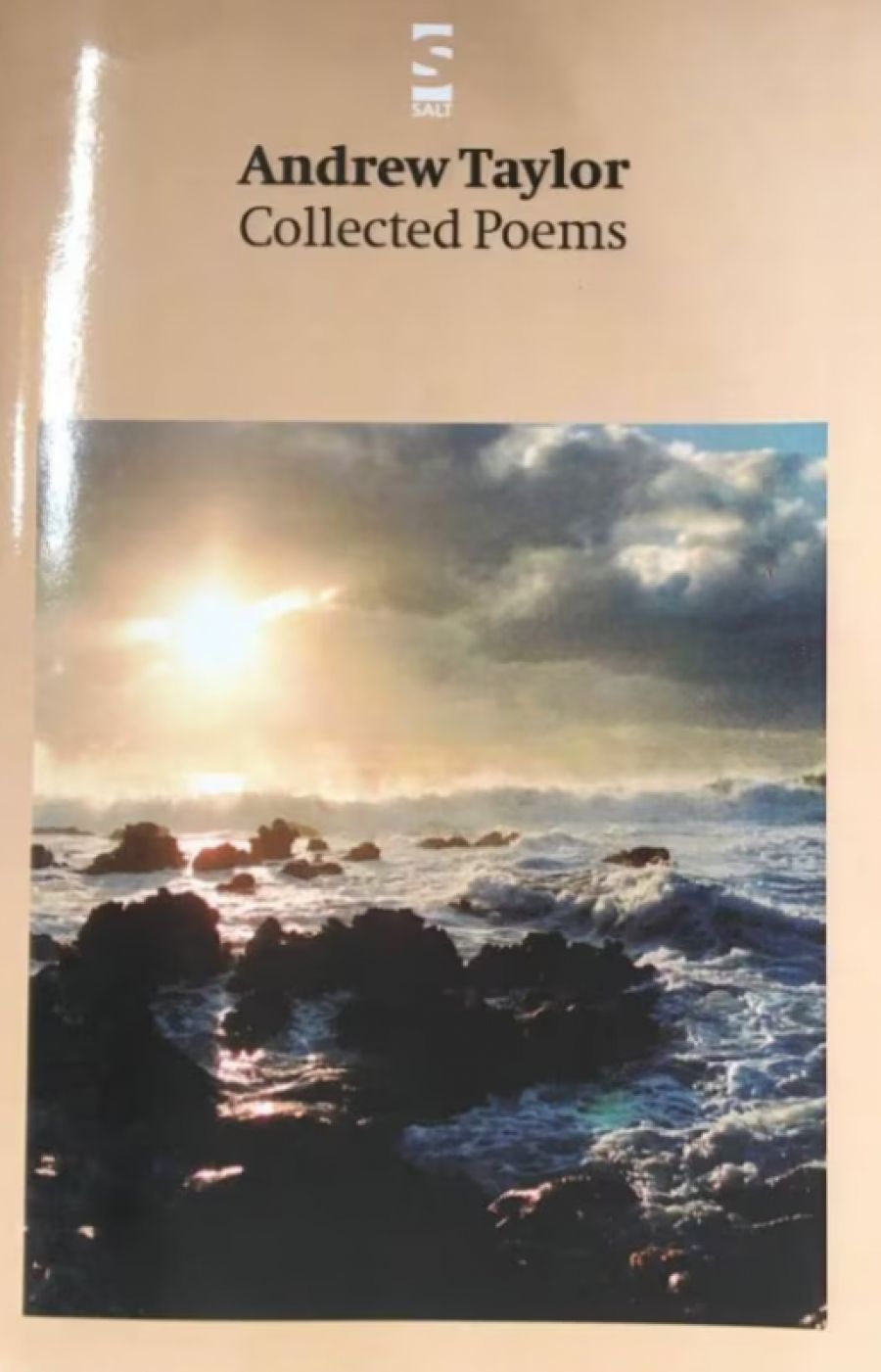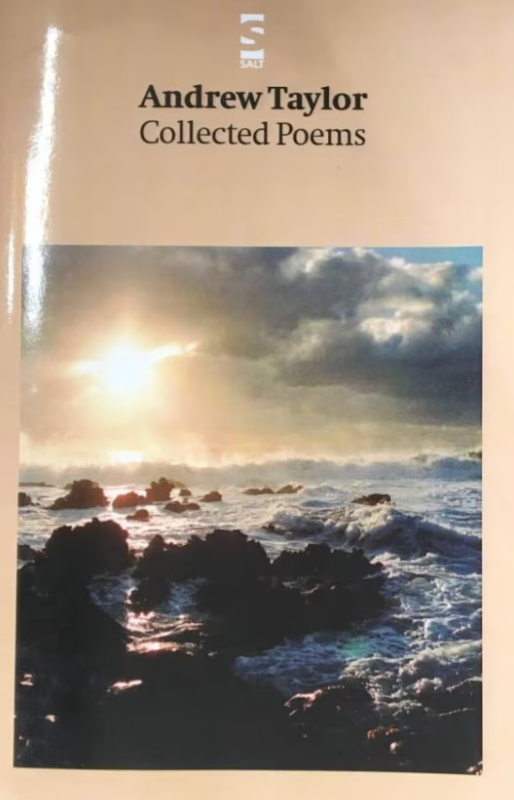
- Free Article: No
- Contents Category: Poetry
- Review Article: Yes
- Article Title: A Different Sugar Bag
- Online Only: No
- Custom Highlight Text:
Andrew Taylor’s Collected Poems is framed by the weather. Indeed, the first poem is entitled ‘The Mere Repetition of Weather’. Weather runs from the ‘Prologue’, to The Cool Change (1971), in which ‘the weather like an alchemist / turns into gold the matter of my arm’, to the last poem in New Poems 2000-2003, ‘The Answer’, in which the poet has ‘come back to the swamp.../ after three years of drought the drenching rain/...flushing green clots of algae’. In another century, this might indicate a Romantic poet, attuned like an Aeolian harp to the motions and stirrings of nature. But this is a poet in whose work can be seen influences of Wallace Stevens, Jonathon Culler, Vincent Buckley, Chris Wallace-Crabbe and John Tranter – an entirely different sugar bag of marsupials.
- Book 1 Title: Collected Poems
- Book 1 Biblio: Salt, US$24.95 pb, 716 pp
- Book 1 Cover Small (400 x 600):

- Book 1 Cover (800 x 1200):

This book evinces a lifetime of poetry. It works out at nearly a page a week for a working life of thirty-five years – an impressive public record of what we might call a master poet, one who constantly practises the craft of poetry, is thinking and feeling poetry, travelling and teaching poetry.
Behind the poems is Taylor’s Reading Australian Poetry (1987), to which I still refer my students. Indeed, the twelve points he makes in the introduction about understanding poetry, in the light of contemporary theory, could be taken as a gloss to this Collected, particularly the notions of language as an indefinitely deferring mediating system of signs; of a poem’s intertextuality, especially where one of the texts is the reader’s complex subjectivity; and that poetry is not ‘truth but text’.
The Collected draws on Taylor’s thirteen books, plus some new poems. It is a pleasure to come across the still impressive ‘Developing a Wife’ and ‘The Nocturne in the Corner Phone Box’, from The Cool Change, or some of the final: poems in Travelling (1986), such as ‘Adelaide’ (‘ It falls apart like a well-dressed / party or a Sunday lunch ... ‘) or ‘Travelling to Gleis Binario’ (‘Humming close to one eighty I topped a rise / onto a little bird. It flew up / with a song dangling from its throat and never knew / what it was to be shredded by a radiator’).
The 1970s was a productive decade for Taylor – six collections culminating in a Selected Poems 1960-1980 (1982) and including the celebrated The Invention of Fire (1976) with its ‘Cathedrals’ poems, which showed Taylor’s skills with a wry, contemporary surrealist brush: for example, ‘cathedrals are collapsing everywhere / housewives find them crumpled in supermarkets / when you open the paper they fall from the Positions Vacant’: and an obliquely confessional nostalgia: ‘where I write poems/ my shirts underwear dumped no pen no paper but / handkerchiefs socks anything that’s mine dumped/ her unironed untamed lyrics / dumped.’ There is also the brief but accomplished collection of prose poems Parabolas (1976), a sequence that interrogates the potential nihilism of metaphor. In the 1980s only Travelling and in the 1990s only Folds in the Map (1991) and Sandstone (1995) were published. Recently, there were Götterdämmerung Café (2001) and New Poems 2000-2003.
In most of the volumes, Taylor likes to divide the poems into about four parts to indicate thematic or stylistic clusters, such as ‘Abstracts’ in The Cool Change; the whimsical ‘Bestiary’ in The Invention of Fire; and the almost epigrammatic ‘Accessories after the Facts’ in Götterdämmerung Café (I like ‘Hat’, ‘Bra’, ‘MobilePhone’ and ‘Tie’).
The most recent poems show a poet who echoes Sir Philip Sidney while focusing on body frailty, and who meditates on speed in the ‘Driving Too Fast’ sequence: ‘Speed is about nearness. That I spin / with the earth registers nothing / on my speedo but should I clip / that oncoming truck it might be zero for me.’ Taylor experiments with formal layout and patterning in ‘T for Too’ and ‘The Whole Story’. Pervading these latest poems is a wise, metaphysical concern with moments, nuances, often from the natural world, as with ‘Goldfish’: ‘they are the impossible longing / of that white ghost / the egret.’ There is a metaphorical inclusiveness in ‘The Swamp Poems’ that reminds me of Robert Adamson; ‘Silk Top’, a poem focusing on a photograph, achieves an almost eidetic poignancy. Pervading these latest poems is a sense of mortality, as in ‘Betrayal’. Writing about his betrayal of himself, Taylor considers the idea of his body: ‘there, where living takes place / at a fast and bloody pace and where wandering entities/ like Medieval monks set up their cells/ proliferate and soon enough / threaten to conquer.’
Taylor’s poems arc included in many anthologies and stitched into the tapestry of Australian poetry like subtle, burnished threads. They show a cool intelligence that is modest, tolerant: caught in moments of utterance, searching for and playing with significance and attuned to their own provisionality. The ‘voice’ is speculative, emotional, formally inventive. both international and regional.
Such a compendious volume – with its handsome, almost sublime cover photograph taken by Sarah Josephi-Taylor – serves Taylor well. I congratulate Salt for the volume’s elegance, but it needs, I suggest, an index of first lines and titles. An extended introductory essay on his poems would be appropriate and timely, too.


Comments powered by CComment